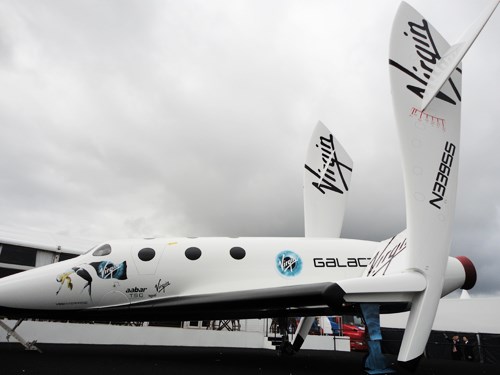Virgin Galactic: After the crash
Although the official cause of the crash of Virgin Galactic's SpaceShipTwo is not yet determined, the evidence seems to indicate premature deployment of the feathering system as the culprit. Virgin Galactic is moving forward with assembly of the second SpaceShipTwo, with lessons learned from the accident surely to be applied.

Second SpaceShipTwo being assembled at Scaled Composites.
Although the U.S. National Transportation Safety Board (NTSB) has yet to complete its investigation of the crash of Virgin Galactic's SpaceShipTwo on Oct. 31, enough information has been revealed already that we can come to some basic conclusions about what likely caused the accident.
The chain of events is simple: SpaceShipTwo was released from its carrier craft and the rocket was fired. As SpaceShipTwo approached Mach 1.0, the copilot, Michael Alsbury, prematurey switched the feathering system from the locked to the unlocked position. Two seconds after that, the craft broke apart when, it appears, aerodynamic forces began to accuate the unlocked feathering system. The feathering system, we have learned, should have been unlocked and deployed at Mach 1.4, when SpaceShipTwo was at its apogee and, presumably, clear of aerodynamic forces that might have interfered with its deployment.
The question, of course, is why the feathering system was prematurely unlocked. Sadly, Michael Alsbury, who died in the crash, cannot tell us. The pilot, Peter Siebold, who did survive, might be able to shed light on the chain of events leading up to the crash, but hasn't done so yet.
Virgin Galactic, for its part, says it and Scaled Composites continue to build the second SpaceShipTwo, which is about 65 percent complete. Presumably, there are lessons to be learned from the crash that will lead to design and engineering changes in the spacecraft. NTSB did say that it is creating a committee to assess the "man-machine interface" in SpaceShipTwo, which likely will address how it was possible to prematurely unlock the feather system.

First SpaceShipTwo, with feathering system deployed, at the 2012 Farnborough International Airshow in Farnborough, U.K.
In the meantime, there are questions being raised about the safety of private spacecraft projects and products, with the implication being that perhaps private spacecraft development should be conducted with greater government and regulatory overight. And certainly we should pay close attention to what the NTSB has to say about this crash and how it might have been avoided. We should bear in mind, however, that spacecraft development, whether done by Scaled Composites, Virgin Galactic or NASA, is inherently risky. Indeed, the entire history of spacecraft development is, unfortunately, littered with accidents and crashes of all types, many of which resulted in injury or death. I presume that Peter and Michael stepped into SpaceShipTwo with some understanding of the risks involved. This is not to suggest that Michael's death should be tolerated or considered acceptable, but the accident in which they were involved should help Scaled and Virgin Galactic move forward with a better understanding of how pilot and machine interact, leading, in the end, to a safer spacecraft and a more reliable flying environment.
Related Content
-
Manufacturing the MFFD thermoplastic composite fuselage
Demonstrator’s upper, lower shells and assembly prove materials and new processes for lighter, cheaper and more sustainable high-rate future aircraft.
-
Welding is not bonding
Discussion of the issues in our understanding of thermoplastic composite welded structures and certification of the latest materials and welding technologies for future airframes.
-
Next-generation airship design enabled by modern composites
LTA Research’s proof-of-concept Pathfinder 1 modernizes a fully rigid airship design with a largely carbon fiber composite frame. R&D has already begun on higher volume, more automated manufacturing for the future.
















